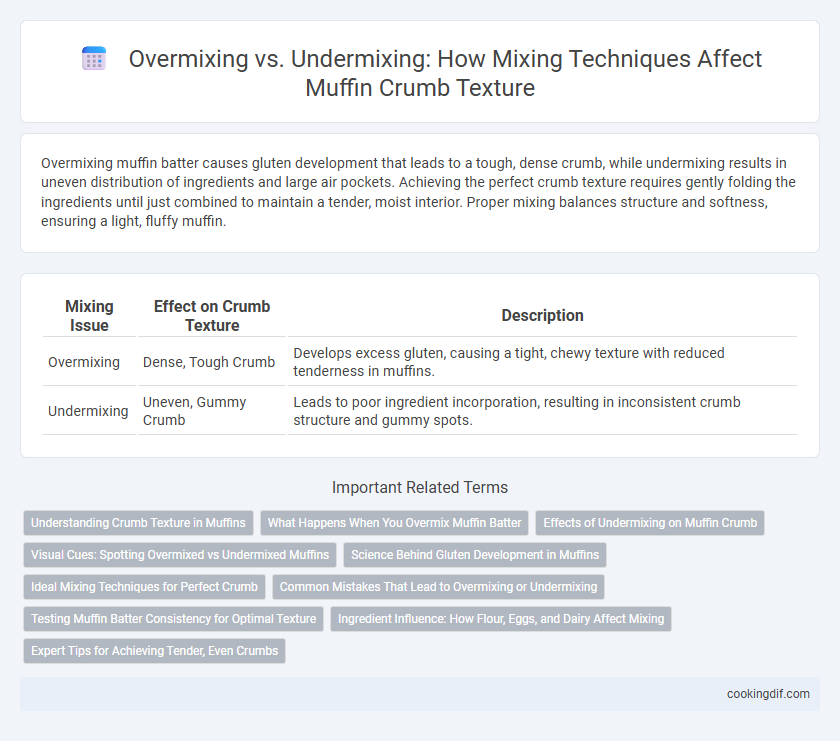Overmixing muffin batter causes gluten development that leads to a tough, dense crumb, while undermixing results in uneven distribution of ingredients and large air pockets. Achieving the perfect crumb texture requires gently folding the ingredients until just combined to maintain a tender, moist interior. Proper mixing balances structure and softness, ensuring a light, fluffy muffin.
Table of Comparison
| Mixing Issue | Effect on Crumb Texture | Description |
|---|---|---|
| Overmixing | Dense, Tough Crumb | Develops excess gluten, causing a tight, chewy texture with reduced tenderness in muffins. |
| Undermixing | Uneven, Gummy Crumb | Leads to poor ingredient incorporation, resulting in inconsistent crumb structure and gummy spots. |
Understanding Crumb Texture in Muffins
Understanding crumb texture in muffins depends largely on the balance between overmixing and undermixing the batter. Overmixing develops excessive gluten, leading to a dense, tough crumb, while undermixing results in uneven distribution of ingredients and a coarse, crumbly texture. Achieving a tender, moist crumb requires gentle mixing just until ingredients are combined, preserving lightness and uniform air pockets.
What Happens When You Overmix Muffin Batter
Overmixing muffin batter causes gluten development to intensify, resulting in a dense, tough crumb instead of a light and tender texture. The excessive mixing traps too much air and promotes uneven rise, leading to tunneling and a gummy mouthfeel. Maintaining a gentle mix ensures a moist, soft crumb with uniform crumb structure ideal for muffins.
Effects of Undermixing on Muffin Crumb
Undermixing muffin batter results in an uneven distribution of ingredients, causing dense and heavy crumb texture with visible pockets of flour. This lack of gluten development often produces a coarse, crumbly muffin that lacks uniform structure. Proper mixing ensures moisture and leavening agents are fully incorporated, which undermixing compromises, leading to poor rise and inconsistent crumb.
Visual Cues: Spotting Overmixed vs Undermixed Muffins
Overmixed muffins display a dense, tough crumb with large air pockets and a peaked or domed top that cracks, signaling gluten overdevelopment. Undermixed muffins have a coarse, uneven crumb with visible streaks of flour and air bubbles that cause tunnels or holes inside. Visual cues like smooth, evenly textured tops and uniform crumb structure indicate proper mixing for ideal muffin texture.
Science Behind Gluten Development in Muffins
Overmixing muffins causes excessive gluten development, resulting in a tough, dense crumb due to the formation of strong gluten networks. Undermixing, however, limits gluten formation, producing a tender, crumbly texture with pockets of unmixed ingredients. Balancing mixing time ensures optimal gluten strands that trap air, yielding a light, moist muffin crumb.
Ideal Mixing Techniques for Perfect Crumb
Ideal mixing techniques for muffins achieve a tender, uniform crumb by carefully balancing ingredient incorporation. Overmixing develops excess gluten, resulting in a dense, tough texture, while undermixing leaves pockets of dry flour and uneven crumb structure. Gently folding wet and dry ingredients until just combined ensures a moist, airy crumb characteristic of perfectly baked muffins.
Common Mistakes That Lead to Overmixing or Undermixing
Common mistakes leading to overmixing muffins include using high-speed mixers or stirring too vigorously, which develops excessive gluten and results in a dense, tough crumb. Undermixing often occurs when ingredients are not fully incorporated, leaving pockets of flour and causing uneven crumb structure and dense spots. Proper mixing involves combining wet and dry ingredients just until moistened to ensure a tender, evenly textured crumb.
Testing Muffin Batter Consistency for Optimal Texture
Testing muffin batter consistency is crucial for achieving the ideal crumb texture, where overmixing causes tough, dense muffins and undermixing results in uneven crumb with large tunnels. Optimal muffin batter should be mixed until just combined, with small lumps remaining to promote a tender, moist crumb. Consistent stirring techniques and batter testing through small batch trials help identify the perfect balance for soft, fluffy muffins.
Ingredient Influence: How Flour, Eggs, and Dairy Affect Mixing
Flour's protein content directly influences gluten development, with overmixing causing tough muffins as gluten overdevelops, while undermixing results in uneven crumb due to insufficient hydration. Eggs provide structure and moisture, where excessive mixing can lead to dense, rubbery texture, whereas undermixing prevents proper emulsification, causing crumb irregularities. Dairy, such as milk or buttermilk, hydrates dry ingredients and activates leavening agents, with overmixing causing broken air bubbles leading to dense crumb and undermixing resulting in coarse, uneven texture.
Expert Tips for Achieving Tender, Even Crumbs
Achieving tender, even crumbs in muffins hinges on precise mixing techniques, where overmixing leads to tough, dense textures due to excessive gluten development, while undermixing results in uneven crumb structure with pockets of dry flour. Experts recommend mixing batter just until ingredients are combined to maintain moisture and lightness, using gentle folding motions rather than vigorous stirring. Incorporating ingredients like buttermilk or yogurt can enhance tenderness and promote a uniformly soft crumb by balancing acidity and moisture retention.
Overmixing vs Undermixing for crumb texture Infographic

 cookingdif.com
cookingdif.com